BBC -o’s analyst in the Middle East
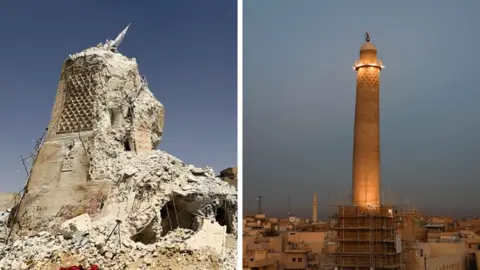 Reuters
ReutersHistorical buildings in Mosul, including churches and mosques, reopen after years of destruction, which are the consequences of taking over the Iraqi city by the extremist group of the Islamic State (IS).
The project, which UNESCO organized and funded, began a year after being defeated and kicked out of the city in 2017 in Northern Iraq.
UNESCO Director General Audrey Azoulay and Iraq Prime Minister Mohammed Shia ‘Al-Sudani attended a ceremony on Wednesday to mark the reopening.
There will also be local craftsmen, residents and representatives of all Mosul’s religious communities.
In 2014, Mosul was busy, which for centuries considered a symbol of tolerance and coexistence between different religious and ethnic communities in Iraq.
The group imposed its extreme ideology to the city, targeting minorities and killing opponents.
Three years later, the coalition supported in the United States in the Alliance with the Iraqi army and militia related to the state set up intensive soil and air offensive to bring back control. The bloodiest battles focused on the Old Town, where the group fighters made the last position.
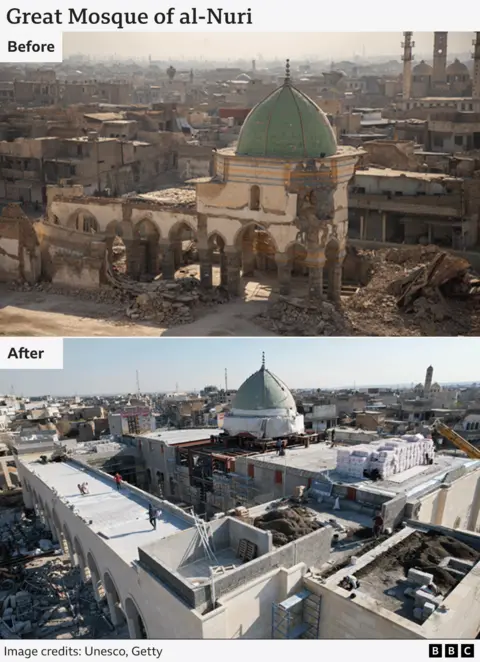
Photographer Mosula Ali al-Baroodi recalls the horror who greeted him when he first entered the area shortly after a battle on the street was completed in the summer of 2017.
In the ruins, he saw in the ruins of the famously distorted al-Hadb Minaret, known as “Hunchback”, which was an emblematic Mosul for hundreds of years.
“It was like the city of ghosts,” he says. “Dead bodies all around, a sick scent and a terrible scene of the city and outlines without outlines without a habad minaret.
“It’s not a city we knew – it was like a metamorphosis – we never imagined in our worst nightmares. After that I was silent for a few days. I lost my voice. I lost my mind.”
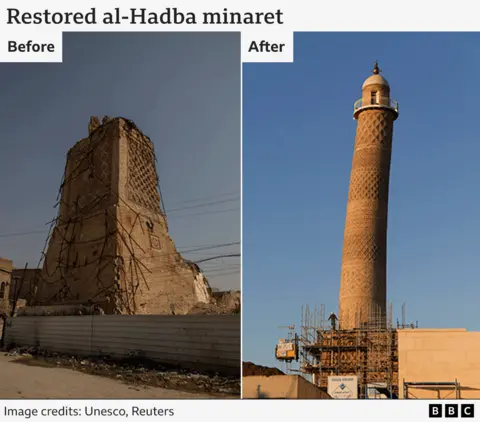
Eighty percent of the old town of Mosul, on the western coast of Tigris, was destroyed during the three-year ISA occupation.
Not only did the churches, mosques and old houses be repaired, but also the spirit of the community of those who have lived so long in the relative harmony between religions and ethnic groups.
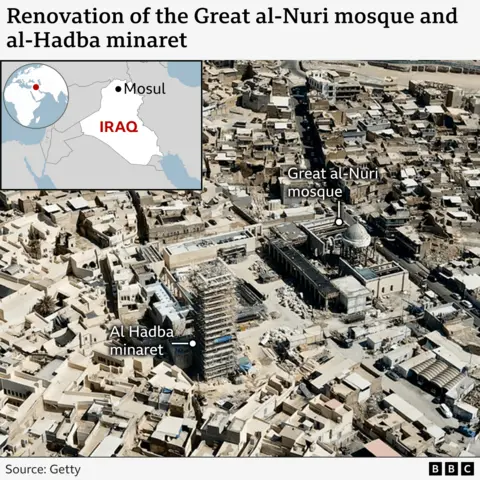
The huge task of renovation began under the auspices of the UNESCO $ 115 million (£ 93 million), which the Agency managed to increase, and most of the United Arab emirates and European Union.
Father Olivier Poquillon – a Dominican priest – returned to Mosul to help monitor the renovation of one of the key buildings, a monastery of Notre -Dame de L’Eure, locally known as Al -sa’a, which was founded almost 200 years ago.
“We started trying to collect the team first – a team that compiled people from Stari Mosul from different denominations – Christians, Muslims who all work together,” he says.
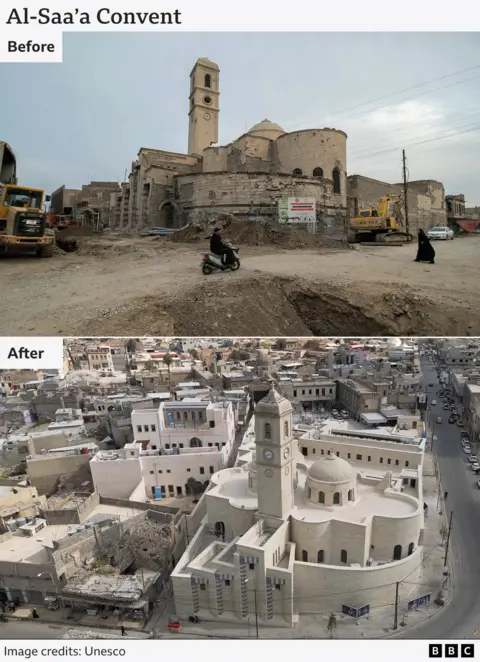
Father Poquillon says the gathering of communities was the biggest challenge and the greatest achievement.
“If you want to renovate buildings that you first renewed trust – if you do not renew trust, it is useless to reconstruct the walls of these buildings because they will become the target of other communities.”
In charge of the whole project – which included the restoration of 124 old houses and two especially fine mansions – was the chief architect Maria Rita Acetoso, who came straight to Mosul from the UNESCO Restoration Affairs in Afghanistan.
“This project shows that culture can also create jobs, it can stimulate skill development, and in addition those who are involved can feel a part of something meaningful,” she says.
He hopes that reconstruction can restore hope and enable the recovery of cultural identity and memories of people.
“I think this is especially important for young generations of growing up in a situation of conflict and political instability,” she adds.
UNESCO says more than 1300 local young people have been trained in traditional skills, while about 6,000 new jobs have been created.
More than 100 classrooms have been renovated in Mosul. Thousands of historical fragments have been recovered and cataloged from ruins.
Among the many engineers involved in renovation, 30% were women.
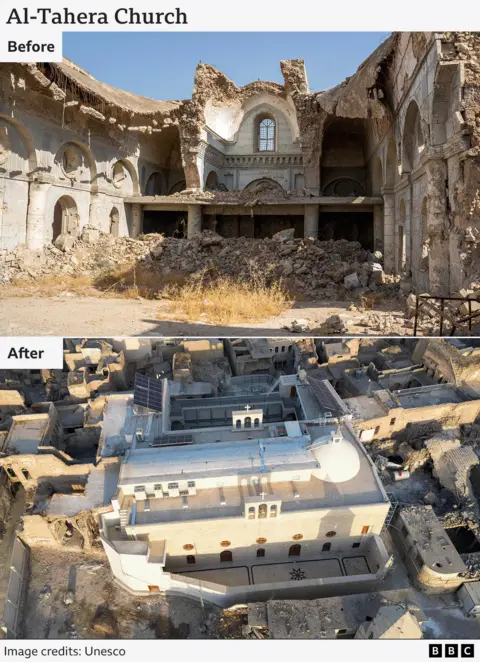
Eight years later, the bells again ring over Mosul from the al-Taher church, whose roof crashed after serious damage under occupation in 2017.
Other major landmarks of Mosula-which blamed the Minaret al-Hadba, the Dominican al-Saaa’a monastery and the Al-Nouri mosque complex.
And people could return to homes that have been home to their families for centuries.
One resident, Mustafa, said: “My house was built in 1864. – Unfortunately, it was partially destroyed during the liberation of Mosul and it was inappropriate to live there, especially with my children.
“So I decided to move to my parents’ house. I was very pleased and excited when I saw my house again.”
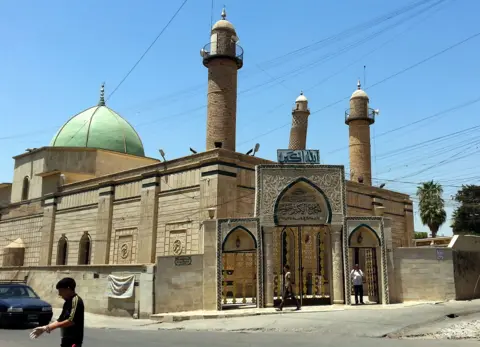 EPA
EPAThe Abdullah family also lived in a house in the old town since the 19th century when the area was the center for wool trade – which is why they say that their home is so valuable.
“After UNESCO renovated his house, I came back,” he says. “I can’t describe the feeling I had because after seeing all the destruction that happened there, I thought I would never be able to go back and live there.”
The scars of what the people from Mosul have suffered to be healed – equally as long as Iraq remains in fragile state.
But the rebirth of the old town from Ruševina represents hope in a better future – because Ali Al -Baroodi continues to document the evolution of his beloved home day by day.
“It’s really like seeing a dead person who returns to life in a very, very beautiful way – it’s a true spirit of a city that returns to life,” he says.

